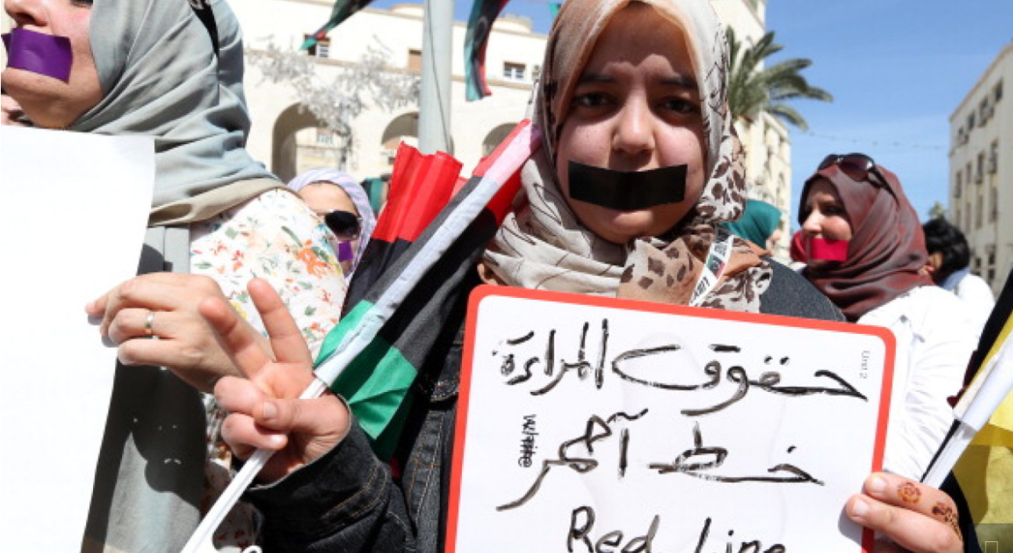
Women's Impoverishment in Libya: Towards Recovering the Lost Self! - Ghadi Kafala

Women's Impoverishment in Libya: Towards Recovering the Lost Self! - Ghadi Kafala
Violence usually occurs within complex contexts that cannot be easily analyzed individually. The dimensions of the violent process vary from one individual to another, from one context to another, and from one community to another.
In places like Libya, which suffers from direct and active conflict and almost complete institutional collapse, the individuality of "violence" takes on a particular character. It constitutes a unique case, easy to distinguish from other contexts. Here, women are at the forefront of confrontation and targeting. However, they may have their own tools to ward off this specter and initiate rebellious initiatives against the lived reality. As Jörg Baberowski said, "Violence is like love. It takes us to a state of wonder." Each individual has their way of understanding violence, whether through admiration or rejection. Thus, the different interpretations and experiences of violence are part of specific human experiences.
Libyan women are always metaphorically portrayed as a clear product of the principles of hybrid socialism of the Gaddafi era, which led to a particular type of feminism known as "feminism without feminists." It is one of the primary strategies of structural violence that guarantees the impoverishment of the women’s movement and its limitations. It was similar to most Eastern European communist countries that granted rights guaranteeing the concepts of family, exclusive marriage, and misguided factionalism.
Thus, the Gaddafi regime utilized a methodology of "legal manipulation" through which it could deceive the angry public and the fragile small communities. A type of mobilization was adopted on issues that appeared to be feminist but which were authoritarian at the core and contradicted women's autonomy and emancipation. An example was the presence of women among the head of the state's security team. Another involved displaying physical strength during major presidential gatherings, just as one would display a fully decorated cake to the public, with mites dancing between its layers of expired contents. It also showed how these women were controlled and considered the ruler's property. Back then, the regime developed in a conflict zone, not on Libyan soil but on the lands of others.
However, even the ambiguity of regimes towards women is a threat. The Libyan regime was one of the most ambiguous systems in terms of its presentation of women. Women were described as immobile beings several times in the Green Book because they menstruate, bleed monthly, carry children, give birth, and breastfeed! The interpretation provided by the ruler is that gender equality cannot be applied in the presence of these biological factors, reducing the word equality to physiological factors!
Libyan women were the product of existing conflicts, one with the exclusive regime and another with "post-regime defects" after 2011. These defects ended up attributing structural and mental weakness to women and their inability to plan, achieve, make decisions, and be led to an integrated revolutionary work. Women were considered tokens until they claimed to want to build the state and its institutions and, thus, formally be present in higher bodies and among decision-makers. Despite many attempts to move towards practical political or party work, the narratives and commandments of weakness covered with protection and interests remained present despite their clarity and the women's ability to dismantle them and access what they conceal easily.
The expanding narratives lead to a specific question: Where are women from translating their rebellious selves into highly private revolutions? Or will they be satisfied with being portrayed as weak and reactionary?
There is no answer! However, Libyan women gained their right to hold judicial positions early. They were held in 1989 by Ms. Rafia Al-Ubaidi and Ms. Fatima Al-Barasi in the Benghazi Primary Court, who fought to preserve women’s gains through their actual presence in the field. According to statistics from the Supreme Judicial Council, there are 3658 members of judicial bodies in Libya. They include 1431 women, at a participation rate of 39 percent.
However, many believe that despite its spontaneity, the revolution's fragility did not yet lead to additional gains in the judicial field or women’s rights to actual political participation.
On the other hand, Libyan women have gone far in practice to present themselves as actors in resolving conflicts and indirect loyalties in tribal and regional wars in 2014 and 2016. On dozens of occasions, they contributed to freeing prisoners of conflicting parties and dampening war fervor. They announced their refusal to be present in endless war environments that carry with them psychological trauma and unhealthy lifestyles.
However, this involvement contributed to the exacerbation of the wave of targeted assassinations of women activists and journalists. Many prominent voices that defended women's rights and contributed to social change were lost. Salwa Bugaighis, who was a symbol of free journalism, was assassinated, followed by Intisar Al-Hassiri, Hanan Al-Barassi, Naseeb Karnafa, and others who risked their lives to express their opinions.
This wave of violence has led to a growing sense of insecurity among women activists, which has dramatically affected their role as initiators of change. Despite their valuable contributions, whether through journalism or street protests, many prefer to withdraw or retreat from public activity.
On the other hand, the largest Libyan archival institution was established in 1977 and holds more than twenty million paper, audio, and video documents. It was called the “Libyan Center for Historical Studies and Archives” and later renamed the “Libyan Jihad Center” in 1980, a name that refers to the reduction of the intersectional archiving of women’s, political, social, and other history to a "jihadist history" obsessed with direct archiving of men and field events that are accompanied by sacrifices of land, displays, and lots of bloody scenes.
The center admitted on several occasions that it was founded in a dominant patriarchal environment that did not give much importance to contexts other than the jihadist and war context. This reality was documented during the center's establishment journey. However, despite all the harsh conditions and individual efforts in its establishment, the founding committee included one woman, Mrs. Najat Al-Qabsi.
The importance of archiving regional wars and conflicts cannot be denied. Still, the center did not give great importance to women's archives. It is evident in its departments' structure, which is primarily based on jihadist and war history against the Italians and documentation of Turkish rule. It is astonishing that despite the nature of its archival practices, the authorities continue to allocate vast sums of money to enhance its archival power.
Similarly, after the 2011 revolution, the authorities neglected to archive the role of women therein and allocate capacities and resources to show women's feelings about the revolution, what it meant and how they interacted with it, and their susceptibility to shock, joy, or suspicion thereof!! These parties did not include Libyan women's vision of the revolution. On the contrary, they established all the standards of femininity. On many occasions, they used them against women who were unable to be present to change policies or participate in a decisive demonstration. However, women used modern archiving methods as an act of resistance and rebellion. Libyan women such as Naziha Aribi, Hadia Qana, and Reem Haqiq were platforms to achieve a better reality and ensure an actual, effective digital presence for all women through their experimental and feature films and interactive works about the reality of women today.
In conclusion, women have never been marginal in the story of a passing conflict. Rather, they were a latent force that challenged accumulated restrictions and expressed itself in various ways, resisting injustice and investing in available spaces to achieve a lasting impact. Despite the distortion of the archives, women's positions are recorded as those that challenge hegemony, with screams that pierce the silence of stories written on the margins of wars.
Recent publications

The Belém Political Package: Institutional Progress or an Illusion Masking Climate Regression? - Rami Abi Ammar
